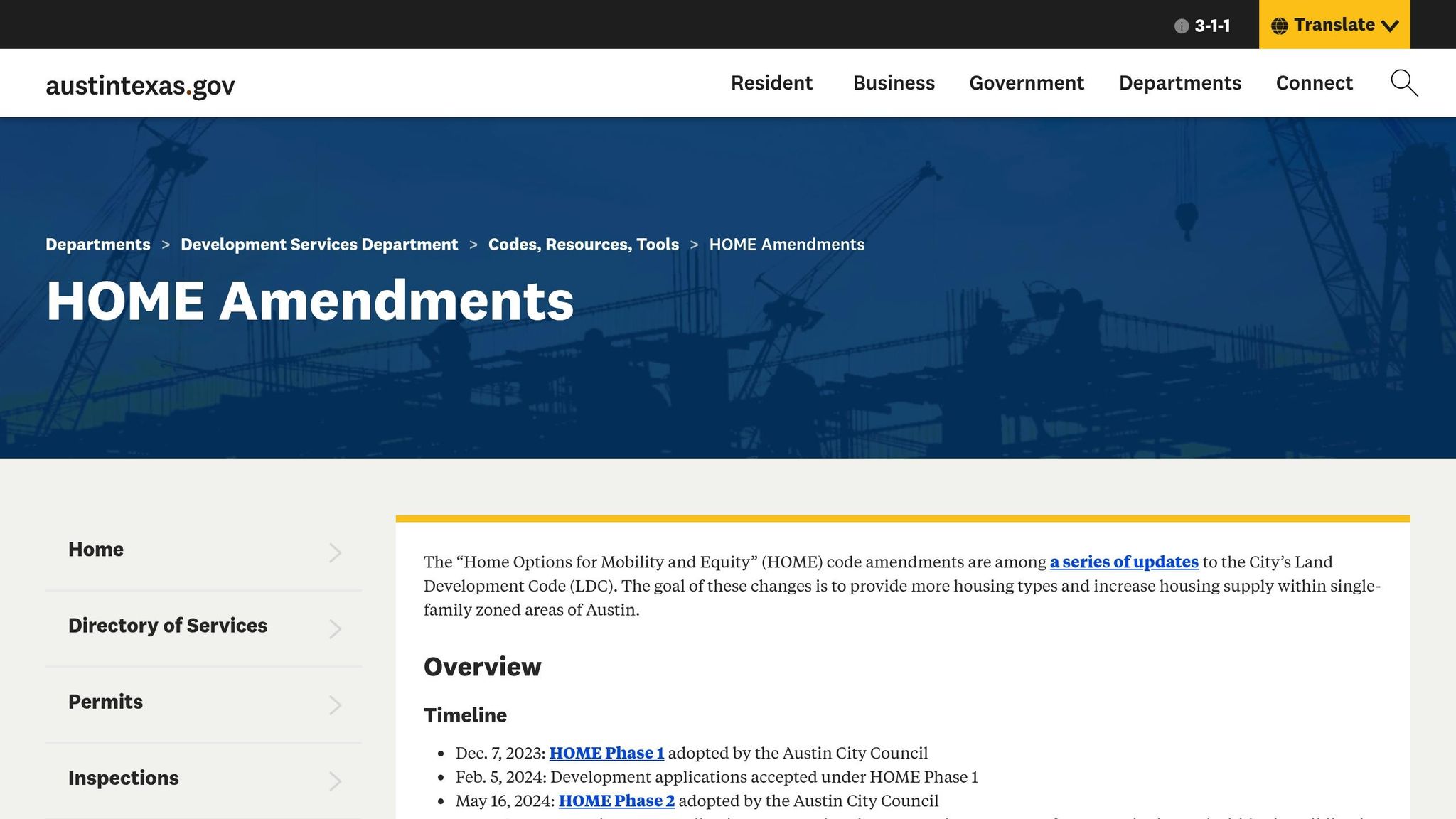The new HOME policy in Austin is reshaping housing development by focusing on affordability, increased housing supply, and sustainability. Here’s what you need to know:
- Faster Permitting: Speeds up project approvals to save time.
- Updated Parking Rules: Reduces parking requirements to match urban living.
- New Density Rules: Allows denser housing with revised floor-area ratios.
- Stricter Environmental Standards: Requires energy-efficient and eco-friendly designs.
Key Challenges for Developers
- Complex Permitting: More detailed plans for zoning, energy, and water use.
- Cost Pressures: Balancing affordability with rising construction costs.
- Infrastructure Issues: Outdated utilities and capacity limits in some areas.
What Developers Can Do
- Plan early and work closely with city officials.
- Use cost-saving programs and energy-efficient designs.
- Choose project sites that align with local infrastructure capacity.
The HOME policy is already driving changes in how housing is built, priced, and designed, offering opportunities for smarter, sustainable development.
‘HOME Initiative‘ set to transform Austin’s housing landscape

Key Challenges for Developers
Developers in Austin face several hurdles under the HOME policy. These issues require thoughtful planning and smart strategies to keep projects on track while meeting new policy standards.
Stricter Zoning and Permit Rules
The HOME policy now requires more detailed documentation for zoning and permits. Developers must include plans for energy efficiency, water conservation, and waste management in their building permit applications, adding complexity to the planning process.
Balancing Costs and Affordability
Rising construction expenses, along with the need to include energy-efficient features, make it harder to meet affordability requirements. Developers must juggle these financial pressures while dealing with physical infrastructure limits that further restrict project feasibility.
Infrastructure and Density Challenges
Outdated utilities and limited grid or stormwater capacity create additional obstacles. These infrastructure constraints can delay projects, especially in areas with strict building limits. Developers need to prioritize early planning and carefully choose sites to align their goals with what the local infrastructure can support.
These challenges highlight the importance of practical strategies outlined in the Developer Guide.
sbb-itb-4c99469
Developer Guide and Best Practices
Here’s how developers can tackle common challenges and ensure a smoother approval process.
Tips for Navigating the Permit Process
Start by connecting with city planning authorities as early as possible. This helps clarify what documentation you’ll need and allows you to address any potential issues before submitting your permits. Early communication can make the review process much more efficient.
Exploring Cost-Saving Programs
Take time to review available programs designed to reduce fees and expenses. Look into eligibility requirements during the planning phase to help keep development costs under control.
Energy-Efficient Construction Strategies
Adopt energy-efficient building techniques to align with policy standards and increase property value. Focus on areas like improving the building envelope, using efficient mechanical systems, and implementing smart energy management tools. These methods not only support sustainability but also lower long-term operational costs.
Market Changes Under HOME Policy
The Austin HOME Policy is reshaping how housing developments are designed and built.
Impact on New Housing
This policy is affecting both the volume and variety of housing projects. Developers are shifting their strategies to align with updated planning rules, while Austin Local Team‘s market analysis highlights shifting trends across neighborhoods.
Affordability and Pricing
Affordability requirements under the HOME Policy are influencing how new homes are priced. Developers are adapting to meet these mandates, opening up opportunities for middle-income buyers. Working with seasoned local experts can provide valuable insights into these market shifts. These pricing changes are also encouraging new approaches to construction.
Evolving Building Designs
The policy is driving changes in construction methods, with developers trying out new building formats to better meet Austin’s housing demands. This shift is leaving a noticeable mark on the city’s skyline.
Conclusion
Key Takeaways
The HOME Policy is reshaping how new construction projects are approached in Austin, pushing developers to align with sustainability goals and growth requirements.
What To Do Next
Here are some practical steps to move forward:
- Stay informed on policy changes through city planning resources and local experts.
- Work closely with city officials during the early stages of planning to ensure projects comply with regulations.
- Incorporate energy-efficient designs that align with both policy standards and market expectations.
